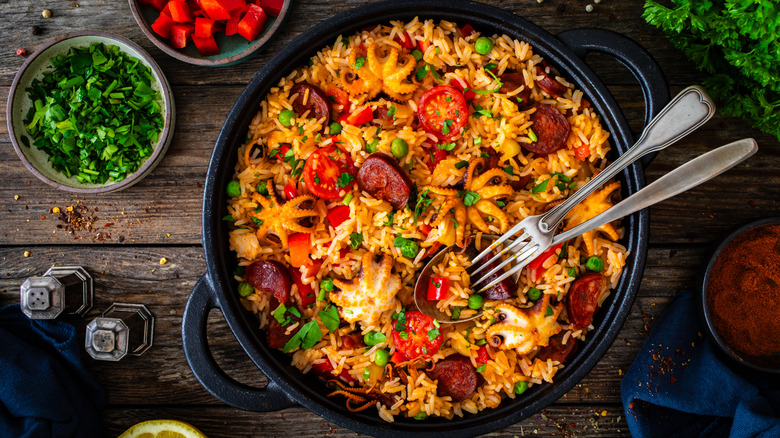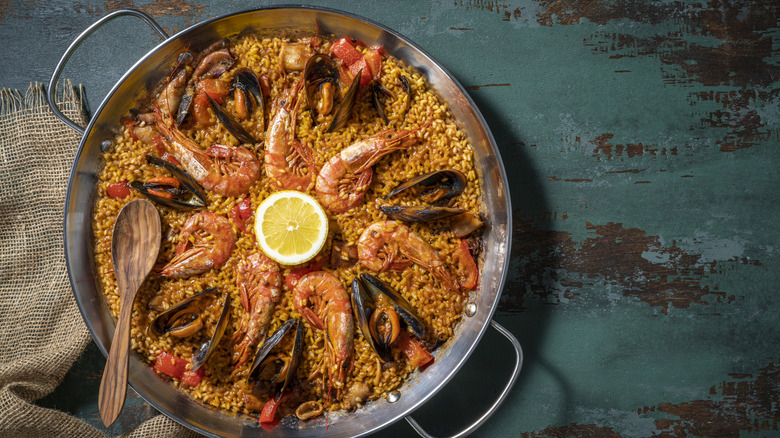A Primer On The Ingredients That Make A Perfect Paella
If you're looking for great paella, you could do worse than to visit The National Hotel Miami Beach. There, executive chef Sergio Chamizo serves several variations on the beloved Spanish rice dish, including artichoke and wild mushroom paella. No time for a Florida foray? No problem: Chamizo gave Mashed the inside scoop on perfect paella — which starts, he says, with the quality of the ingredients.
"I'd rather not use an ingredient if it's not fresh or great quality," says Chamizo, who was born in Barcelona and raised in Madrid. Quality is especially important when it comes to the rice — you need short, round varieties optimal for soaking up the flavorful cooking liquid. Arborio works in a pinch, but the classic choices, Bomba and Calasparra, are well worth seeking out. Rice and stock are typically added to paella with saffron, which gives the dish its scarlet blush.
Before that, though, you'll build a base of flavor with sofrito, the sautéed blend of aromatics (onion, bell pepper, garlic) common across Mediterranean and Latin American cuisines. Chamizo mentions Salmorreta sofrito, a regional variation that includes tomatoes, parsley, ñora peppers, and garlic. Add just enough garlic to "enhance the sofrito," he says. "You should not overdo it." For onions, Chamizo prefers green ones — and makes sure they're well caramelized. Sofrito benefits from not being rushed: The longer it cooks, the deeper its flavor. Sofrito, rice, and stock are paella's basic building blocks. Now comes the fun part: deciding what to top it with.
The many different variations on paella
An early iteration of paella Valenciana was topped with rabbit and snail. Today, it's likelier to come with add-ons like chorizo and shrimp — though, in Spain, variations abound. "Every single town in the coast of Spain has its own recipe with different ingredients," Sergio Chamizo says. One preparation he's particularly fond of? Arroz al horno, which incorporates blood sausage, chickpeas, pork ribs, and potatoes: "This is a rice originating from the interior of Valencia, cooked in a terra-cotta pan." Closer to the Mediterranean, you might encounter paella de mariscos, with shrimp, mussels, squid, and other briny treasures.
Not that you have to choose: You might also opt for paella mixta, which combines meats (like chorizo, chicken, or pork) with fish or shellfish. Vegetable paellas are a respectable option — recall Chamizo's artichoke and wild mushroom version, which he serves with onion aioli. (Creamy, garlicky aioli is a classic condiment alongside paella.) On his restaurant menu, Chamizo also offers black paella, another popular variation, in which the rice gets its midnight hue from the addition of squid ink. To complete the seafood theme (and to make an especially dramatic presentation), this dish is commonly topped with things like shrimp and squid.
You just want to make sure not to overcrowd the dish — more on that, and other common paella mistakes, here. Master the basics of paella, in short, and there's pretty much no end to the personal spins you can put on it.

